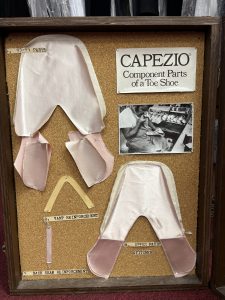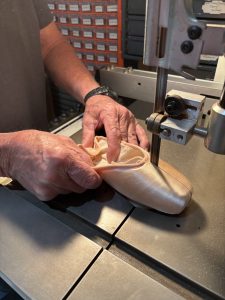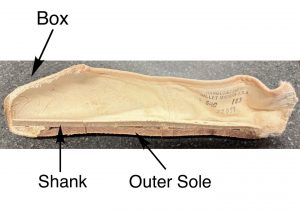Week 1: Sole Searching
Katie b -
This week I began my journey into the inside of a pointe shoe.
Over the weekend, I attended one of my routine pointe shoe fittings with a specialist in Phoenix. After receiving my new pair of shoes, I began telling him about my senior project. He then showed me a display of the traditional stages of making a pointe shoe.



My eyes were immediately drawn towards the shank. The most confusing part of this shank was the raised portion towards the top. When I asked him about this, he had a very strong answer. He explained to me that the Capezio brand previously added this raised portion in order to increase the durability of the shoe. However, dancers and stage directors hated it. He told me that that little extra piece made the shoes much louder when jumping. Hearing that little fun fact made me realize another factor that I will need to consider when adjusting the materials and design of the shank: sound. Pointe shoes are supposed to make ballet look effortless and magical, but a dancer can’t achieve this if her shoes are extremely noisy.
After explaining the various steps on the display board, my pointe shoe fitter gifted me a brand new pair of shoes for my project. I am incredibly grateful for these shoes, as without them, I wouldn’t be able to demonstrate what a new pair looks and feels like, since all of my old ones are worn out.
Now here’s where the fun began. I took this new pair back to my house, and with the help of my grandpa, I was able to cut one shoe in half. We used a saw to cut from the toe box all the way down through the heel.




Now that it was opened up, we could clearly see the various layers and parts. In this very traditional style of shoe, you can see that the shank is completely flat with no bend or arch support. It is the muscles in a dancer’s foot that cause the shoe to bend while in use. This is something I plan to alter in my design. I believe that if the shoe is not constantly being bent out of its original state, the materials will not experience as much wear and tear.
With the new knowledge I have gained about the traditional interior design, I am ready to start my own design with new materials next week.

Comments:
All viewpoints are welcome but profane, threatening, disrespectful, or harassing comments will not be tolerated and are subject to moderation up to, and including, full deletion.